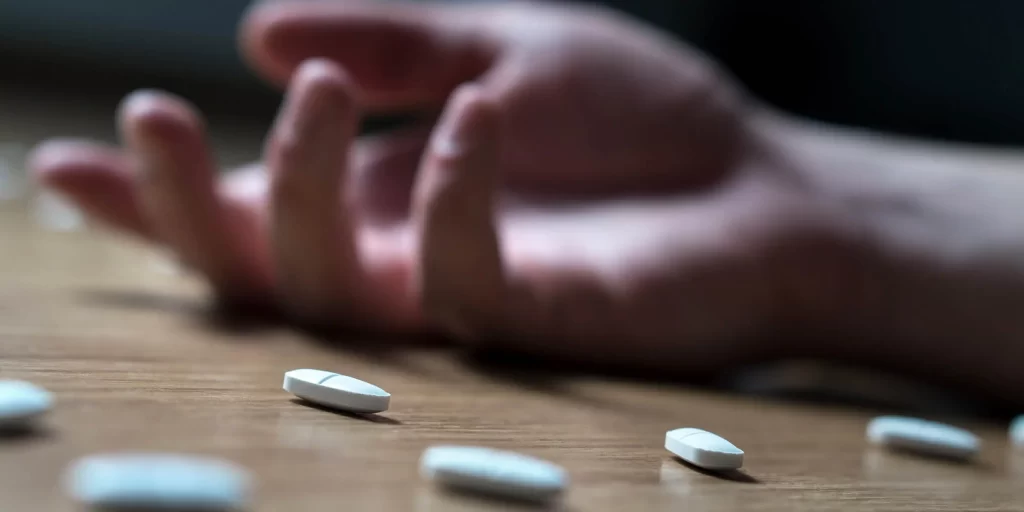Hydrocodone Overdose Signs and Symptoms
Written by Megan Hull
& Medically Reviewed by Kathleen Oroho Linskey, PharmD
Medically Reviewed
Up to Date
Last Updated - 6/17/2022
View our editorial policy
Hydrocodone is a prescription pain reliever and cough reducer that is available by itself or in combination with other medicines. Hydrocodone is classified as a semisynthetic opioid and, although it is approved as a cough reducer, it is most often prescribed for the management of severe pain. Some of the commercially available brand names of hydrocodone products are Anexsia, Hysingla, Zohydro ER, Vicodin, Norco, Lorcet, Lortab, Hycodan, Zydone and Tussionex.
It is estimated that more than 130 people in the United States die from an opioid overdose every day. The opioid epidemic is an overwhelming national crisis and the high prevalence of the abuse of hydrocodone makes it one of the main contributors to overdose deaths across the United States. Recognizing the symptoms and side effects of hydrocodone overdose and knowing the appropriate actions to take for treatment can be lifesaving in an overdose situation.
Hydrocodone Overdose Signs and Symptoms
Knowing how to recognize hydrocodone overdose symptoms can be lifesaving in an emergency situation.
Signs of overdose on hydrocodone include:
- Pale skin that feels clammy to the touch
- Slowed or stopped heartbeat
- Vomiting
- Limpness
- Fingernails or lips that turn blue or purple color
- Being unable to speak
If you think you or someone else may have overdosed on hydrocodone, you should:
- Call 911 immediately
- Administer naloxone, if it is available
- Try to keep the individual breathing and awake
- Lay the person on their side to prevent choking
- Stay with the individual until emergency workers arrive
What Happens if You Overdose on Hydrocodone?
Hydrocodone and other opioids have their effect as pain relievers because they affect specific receptors in the body. The main opioid receptors that affect what happens if you overdose on hydrocodone are called mu receptors.
When hydrocodone enters the system, it triggers actions of the mu receptors which result in a release of dopamine and other neurochemicals that promote feelings of pain relief and a euphoric sensation. These are the intended or desirable actions of hydrocodone. However, during an overdose, there is an overwhelming response from receptors in the sections of the brain that manage breathing rate.
In an overdose, the breathing rate drops too low and causes the blood to become deoxygenated. Because the blood is lacking sufficient oxygen, this results in decreased heart rate, severe drowsiness, loss of consciousness, coma and possibly death. Even if a person is successfully revived from a hydrocodone overdose, they could have significant injury or damage to certain body systems due to the lack of oxygen that was experienced during the overdose.
Dangers of Overdose
Taking excessive amounts of hydrocodone can cause slowed or stopped breathing. The action of breathing is vital to every function of the body, and when there is a significant loss of oxygen from reduced breathing, any organ system can be affected and injured. The most dangerous effect of overdose is death due to complete loss of the ability to breathe.
Even if a person survives an overdose, they may have significant damage to certain body systems, including the gastrointestinal system and kidneys. Also, hydrocodone overdose could result in a coma that would require breathing assistance, blood transfusions and other supportive care to keep the person’s body alive while their brain recovers from significant injury.
Suicide from Hydrocodone Overdose
A recent study found that the deaths due to suicide and unintentional drug overdoses more than doubled between 2000 and 2017. In 2017, more than 40% of suicides and drug overdose deaths involved the misuse of opioids. Proper treatment and management of hydrocodone dependence must include thorough counseling and psychiatric treatment to ensure that the individual is not at risk for self-harm.
If you or someone you know is having suicidal thoughts, don’t wait to get help. Call your doctor immediately, go to an emergency room or call the National Suicide Prevention Lifeline at 1-800-273-TALK (8255). If you’d rather not speak to a person, you can reach the Crisis Text Line by texting HOME to 741741 from anywhere in America.
Hydrocodone Overdose Statistics
Many times, national and state reports regarding opioid overdoses do not specify each individual medication, but rather group them together by type of opioid. Hydrocodone falls into the classification of semisynthetic opioid. While the actual number of overdoses due to hydrocodone is largely unknown, taking a look at the staggering statistics related to hydrocodone use and opioid overdoses can be eye-opening.
Some significant hydrocodone statistics to consider when discussing the risk of hydrocodone overdose include:
- Hydrocodone has been identified by the DEA as the most frequently prescribed opioid in the United States, with more than 83.6 million prescriptions dispensed in 2017
- The National Institute of Health estimates that about 10% of U.S. adults have a drug use disorder at some point in their lives
- Emergency room visits for opioid overdoses increased by 30% on average for all states in the United States, with a 70% increase found in Midwestern states and a 54% increase found in large cities from July 2016 to September 2017
- It is estimated that about 70% of people who use drugs will witness an overdose at some point in their lives
Understanding the prevalence of hydrocodone misuse and the risk associated with hydrocodone overdose could help save a life.
Hydrocodone Overdose Deaths
It can be difficult to find specific numbers related to hydrocodone overdose deaths. However, considering the widespread availability of hydrocodone, it is reasonable to conclude that hydrocodone has contributed to a staggering amount of overdose deaths.
Some important statistics to consider when understanding the prevalence of hydrocodone overdose deaths include:
- Over 17,000 drug overdose deaths during 2017 involved prescription opioids, which is a nearly 500% increase from the amount of prescription opioid overdose deaths in 1999
- It is estimated that more than 130 people in the United States die from an opioid overdose every day, with approximately 46 of those deaths being directly linked to the use of prescription opioids
Recent changes in prescribing practices have helped reduce the availability of prescription opioids for misuse. However, we are still facing a serious national crisis. Understanding the prevalence and risks of a hydrocodone overdose could further prevent tragedy.
Hydrocodone Overdose Treatment
The most effective treatment hydrocodone overdose treatment is the administration of Narcan (naloxone). Narcan is a medication approved for use to reverse the deadly effects of respiratory and circulatory depression possible with opioid overdose. Naloxone can be administered by injection or nasal spray. It’s recommended that family members or friends of people living with substance use disorder have naloxone nasal spray on hand to provide lifesaving treatment in the event of an overdose.
Anytime a person overdoses, even if they have been successfully treated with naloxone, you should call 911 and seek immediate medical attention to ensure that the dose of naloxone was adequate and there was no significant injury caused by the overdose. Hydrocodone overdose is serious and hydrocodone overdose treatment should be managed by trained health care professionals in a hospital setting to ensure the best possible outcome.
Hydrocodone Overdose Prevention
There are some precautions that can be taken to prevent a hydrocodone overdose, including:
- If you are prescribed hydrocodone by your doctor, only take it as ordered — do not take more medicine at once or take it more often than the doctor has ordered
- Do not mix hydrocodone products with alcohol, sleeping medications, other opioid painkillers or illegal substances
- Store hydrocodone products safely and securely where children, pets and unintended users can’t access it
- Dispose of any unused medicine properly
If you or someone you know is living with a substance use disorder, appropriate and proactive treatment is the best way to prevent an overdose. The Recovery Village Ridgefield offers compassionate and comprehensive addiction treatment programs led by specialists. The road to recovery does not have to begin with an overdose; it can begin with a positive choice to seek help and treatment. To learn more about treatment that could help you, contact The Recovery Village Ridgefield today to speak with a representative.
Sources
Bohnert, Amy S.B., et al. “Understanding Links among Opioid Use, Overdose, and Suicide.” The New England Journal of Medicine, January 3, 2019. Accessed August 10, 2019.
Centers for Disease Control and Prevention. “Opioid Overdoses Treated in Emergency Departments.” March 16, 2018. Accessed August 10, 2019.
Centers for Disease Control and Prevention. “Prescription Opioid Data.” Updated December 19, 2018. Accessed August 10, 2019.
Drug Enforcement Administration. “Hydrocodone.” October 2018. Accessed August 10, 2019.
Food and Drug Administration. “Hysingla ER.” Revised September 2018. Accessed August 10, 2019.
MedlinePlus. “Opioid Overdose.” Accessed August 10, 2019.
National Institute on Drug Abuse. “Overdose Death Rates.” Revised January 2019. Accessed August 10, 2019.
National Institute on Drug Abuse. “Opioid Overdose Crisis.” Revised January 2019. Accessed August 10, 2019.
National Institute of Health. “10 percent of US adults have drug use disorder at some point in their lives.” November 18, 2015. Accessed August 10, 2019.
Schiller, Elizabeth Y., et al. “Opioid Overdose.” StatPearls, January 2019. Accessed August 10, 2019.
World Health Organization. “Management of substance abuse: Information sheet on opioid overdose.” Revised August 2018. Accessed August 10, 2019.
View Sources
Bohnert, Amy S.B., et al. “Understanding Links among Opioid Use, Overdose, and Suicide.” The New England Journal of Medicine, January 3, 2019. Accessed August 10, 2019.
Centers for Disease Control and Prevention. “Opioid Overdoses Treated in Emergency Departments.” March 16, 2018. Accessed August 10, 2019.
Centers for Disease Control and Prevention. “Prescription Opioid Data.” Updated December 19, 2018. Accessed August 10, 2019.
Drug Enforcement Administration. “Hydrocodone.” October 2018. Accessed August 10, 2019.
Food and Drug Administration. “Hysingla ER.” Revised September 2018. Accessed August 10, 2019.
MedlinePlus. “Opioid Overdose.” Accessed August 10, 2019.
National Institute on Drug Abuse. “Overdose Death Rates.” Revised January 2019. Accessed August 10, 2019.
National Institute on Drug Abuse. “Opioid Overdose Crisis.” Revised January 2019. Accessed August 10, 2019.
National Institute of Health. “10 percent of US adults have drug use disorder at some point in their lives.” November 18, 2015. Accessed August 10, 2019.
Schiller, Elizabeth Y., et al. “Opioid Overdose.” StatPearls, January 2019. Accessed August 10, 2019.
World Health Organization. “Management of substance abuse: Information sheet on opioid overdose.” Revised August 2018. Accessed August 10, 2019.
Authorship

 Insurance
Insurance About Us
About Us Our Facility
Our Facility Admissions
Admissions Programs
Programs Medical Detox
Medical Detox Inpatient Rehab
Inpatient Rehab Aftercare & Recovery
Aftercare & Recovery



